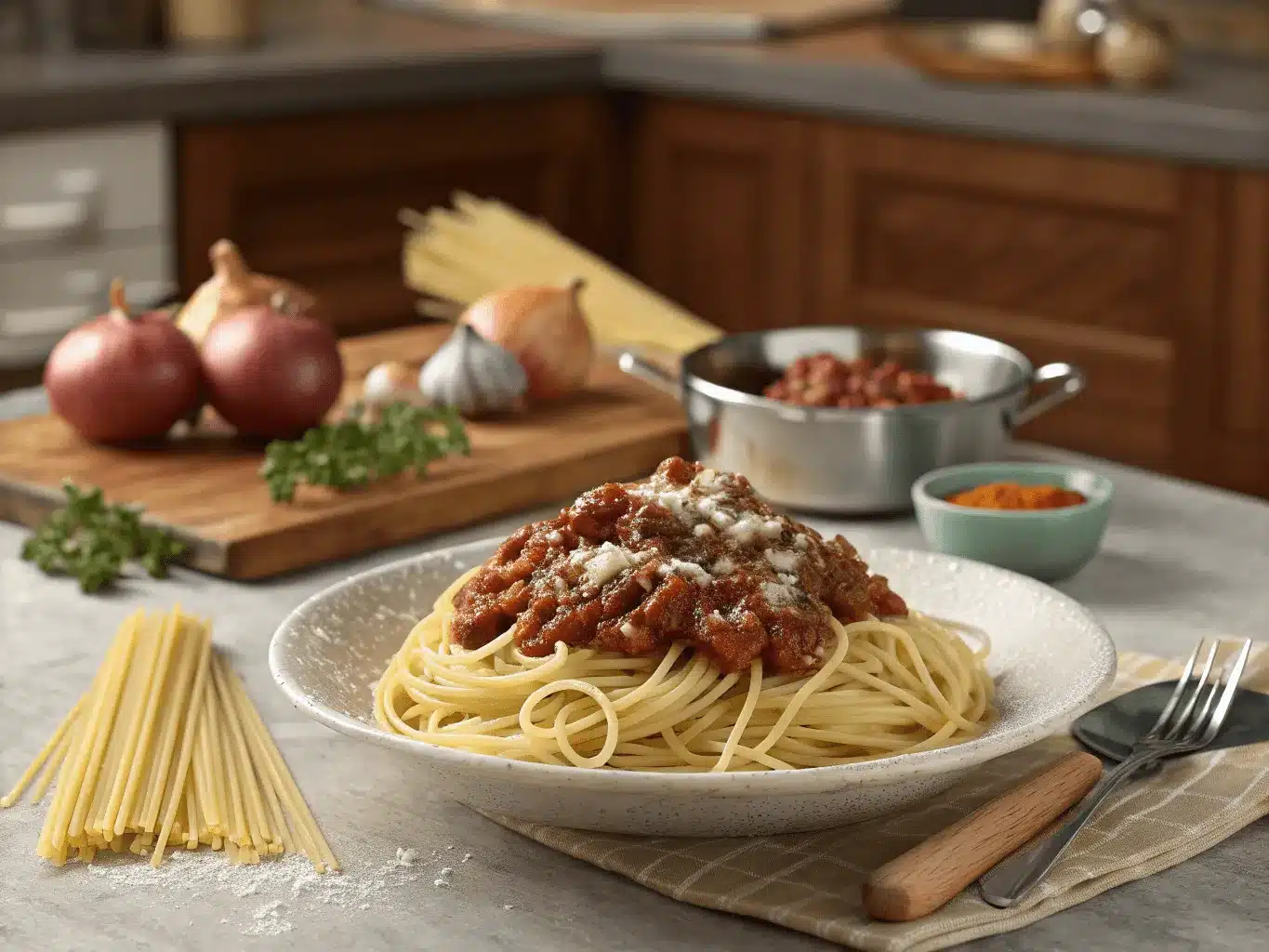Spaghetti Bolognese Recipe is a classic, comforting dish that has found a place in households around the world. This delicious Italian recipe combines rich, hearty flavors with simple ingredients, making it a favorite for family dinners and special occasions alike. In this guide, we’ll show you how to make the perfect spaghetti bolognese that is full of authentic flavor and easy to prepare. Whether you’re a seasoned cook or a beginner in the kitchen, this recipe will bring joy to your table and impress everyone.
What is Spaghetti Bolognese Recipe?
Spaghetti Bolognese is a traditional Italian dish that features a meat-based sauce, typically prepared with ground beef, vegetables, and a mixture of flavorful herbs and spices. The sauce, also known as Bolognese sauce or ragù alla bolognese, originates from the Italian city of Bologna. Although variations exist, the essence of this dish remains rooted in its slow-simmered, rich meat sauce that combines beautifully with pasta to create a satisfying meal.
Learn more about the history of Italian cuisine here.
Ingredients of a Traditional Spaghetti Bolognese Recipe
To create an authentic Spaghetti Bolognese Recipe, you’ll need a mix of vegetables, ground meat, tomatoes, herbs, and, of course, a dash of wine to enhance the flavor. Here are the key ingredients for making the perfect Bolognese sauce:
- Ground Beef: Provides the rich, meaty flavor that forms the heart of the sauce.
- Carrots, Celery, and Onion: These are finely chopped and serve as the base to build depth and flavor.
- Garlic: Adds an extra layer of taste that complements the meat.
- Tomato Paste & Crushed Tomatoes: Gives the sauce its thick, rich texture and signature flavor.
- Red or White Wine: Used to deglaze the pan and add complexity to the sauce.
- Milk: Helps soften the acidity of the tomatoes and gives the sauce a creamy finish.
- Olive Oil: Used to sauté the vegetables.
- Herbs and Spices: Bay leaves, oregano, and basil bring out the classic Italian flavors.
How to Make the Perfect Spaghetti Bolognese Recipe
Making Spaghetti Bolognese Recipe is all about the process—taking time to build layers of flavor, allowing the ingredients to meld together, and cooking low and slow. Here is a detailed, step-by-step guide to preparing a mouth-watering Spaghetti Bolognese Recipe.
Step 1: Prepare the Base
Start by heating olive oil in a large skillet or pot over medium heat. Add the finely chopped onion, carrot, and celery. Sauté these vegetables until they are soft and fragrant, about 5-7 minutes.
Step 2: Cook the Meat
Add the ground beef to the skillet. Use a wooden spoon to break up the meat into smaller pieces as it browns. Cook for 6-8 minutes, or until the beef is no longer pink. Adding a pinch of salt during this step helps draw out moisture from the meat, allowing it to brown better.
Step 3: Add the Flavorings
Cook for 1-2 minutes, allowing the tomato paste to darken slightly. Then, pour in the red or white wine and let it simmer until most of the liquid has evaporated. This will deglaze the pan, lifting all those delicious browned bits that add depth to the sauce.
Step 4: Simmer the Sauce
Next, add the crushed tomatoes, a bay leaf, and a sprinkling of oregano and basil. Reduce the heat to low and let the sauce simmer gently for at least an hour, preferably longer. The longer the sauce simmers, the deeper the flavors will become. If the sauce gets too thick, add a splash of water or broth.
Step 5: Finish with Milk
Towards the end of the cooking time, stir in a small amount of milk. This will soften the acidity of the tomatoes and add a creamy texture to the sauce, making it incredibly luxurious.
Step 6: Cook the Spaghetti
While the sauce simmers, bring a large pot of salted water to a boil. Add the spaghetti and cook according to the package instructions until al dente. Drain the pasta, but reserve a small cup of the cooking water.
Step 7: Combine and Serve
Add the cooked spaghetti to the sauce, tossing to coat evenly. If needed, add a bit of the reserved pasta water to help the sauce cling to the noodles. Serve hot, topped with freshly grated Parmesan cheese and a sprinkle of chopped parsley for garnish.
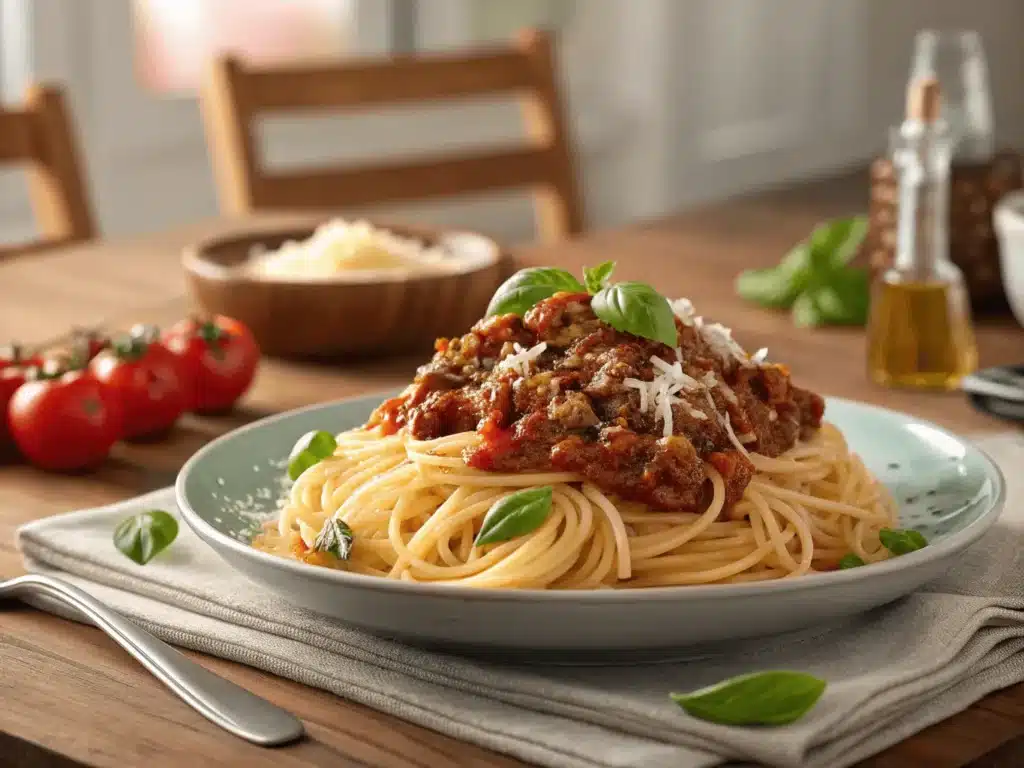
Pro Tip: Serve your Spaghetti Bolognese Recipe with a side of garlic bread and a simple green salad to make it a complete meal.
The History of Spaghetti Bolognese Recipe
The history of Spaghetti Bolognese Recipe is rooted in the rich culinary traditions of Bologna, a city in northern Italy known for its indulgent and hearty cuisine. The original version of ragù alla bolognese dates back to the 18th century, with early recipes featuring a blend of meats, including pork, veal, and even chicken livers. It wasn’t until Italian immigrants brought their cooking traditions to other parts of the world that the dish evolved into the version now popular globally—featuring spaghetti as the pasta of choice.
Bologna is located in the Emilia-Romagna region of Italy, which is also home to some of the country’s most famous culinary exports, including Parmesan cheese, prosciutto, and balsamic vinegar. The region is known for its rich, hearty dishes that are meant to be enjoyed slowly, often accompanied by a glass of local wine. The origins of Bolognese sauce reflect this tradition, with its emphasis on slow cooking and layered flavors.
Over time, different variations of Bolognese sauce have emerged, each adding its unique twist. In Italy, Bolognese sauce is often served with wide, flat pasta like tagliatelle or fettuccine, which better holds the rich, thick sauce. In the United States and other countries, however, the sauce is typically paired with spaghetti, resulting in the dish we now call spaghetti bolognese.
Tips for Perfecting Your Spaghetti Bolognese Recipe
While making Spaghetti Bolognese Recipe is relatively straightforward, there are several tips and tricks that can elevate your dish from good to great:
- Use Quality Ingredients: The quality of the ingredients you use can significantly impact the final dish. Opt for fresh vegetables, high-quality ground beef, and San Marzano tomatoes if available. The better your ingredients, the richer and more authentic the flavor will be.
- Don’t Rush the Process: The key to a deep, flavorful Bolognese sauce is patience. Allow the sauce to simmer for at least an hour, if not longer. The slow cooking process allows the flavors to meld together, resulting in a richer, more complex sauce.
- Deglaze with Wine: Adding red or white wine to the pan after browning the meat is essential for deglazing, which means lifting all those delicious browned bits from the bottom of the pan. This adds a depth of flavor that makes a big difference in the final sauce.
- Season at Every Step: Layering flavor is crucial in Italian cooking. Add a pinch of salt to the vegetables as they sauté, season the meat as it browns, and taste the sauce periodically as it simmers. This ensures that the final dish is well-balanced and flavorful.
- Add Milk for Creaminess: Adding a small amount of milk or cream toward the end of the cooking process helps to mellow out the acidity of the tomatoes and adds a subtle richness to the sauce.
- Finish with Fresh Herbs: While dried herbs like oregano and bay leaves are great for simmering in the sauce, finishing with fresh basil or parsley adds a burst of fresh flavor that brightens up the dish.
Variations of Spaghetti Bolognese Recipe
While the classic Spaghetti Bolognese Recipe is made with ground beef and tomato sauce, there are several delicious variations that you can try to add a unique twist to the dish:
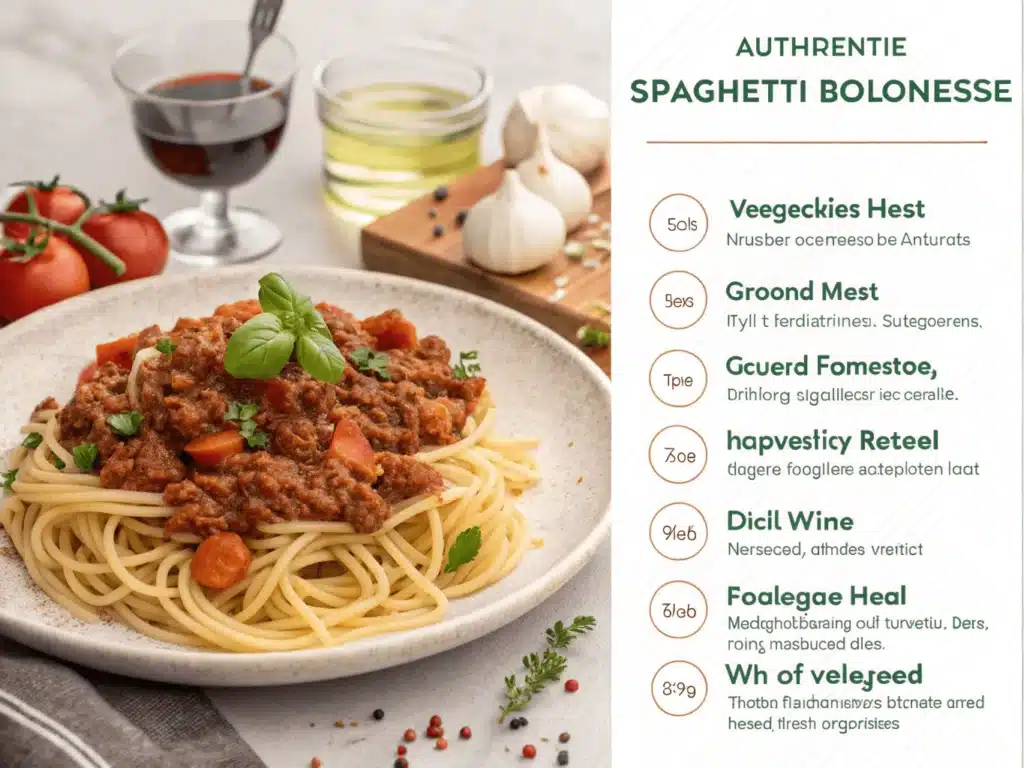
1. Turkey Bolognese
For a lighter version of the classic dish, substitute ground turkey for ground beef. Turkey Bolognese is lower in fat but still packed with flavor. Adding a bit of olive oil while browning the turkey can help to maintain moisture and ensure a rich taste.
2. Vegetarian Bolognese
If you prefer a meatless option, try making a vegetarian bolognese using lentils or mushrooms in place of the meat. Lentils provide a similar texture to ground meat, while mushrooms add a savory, umami flavor that mimics the richness of traditional Bolognese sauce. You can also use a combination of both for an even heartier dish.
3. Spicy Bolognese
If you like a bit of heat, try adding red pepper flakes or chopped chili peppers to the sauce. A spicy bolognese can add an exciting twist to the traditional recipe, perfect for those who enjoy a little kick in their meals.
4. Creamy Bolognese
For an even creamier version, you can add a generous splash of heavy cream towards the end of cooking. This will create a creamy bolognese sauce that is velvety smooth and pairs wonderfully with fettuccine or pappardelle.
5. Seafood Bolognese
For a completely different take, consider making a seafood bolognese using a combination of shrimp, scallops, and white fish. Substitute the beef broth with fish stock, and add a bit of white wine and lemon juice for a bright, coastal twist on the classic dish.
Serving Suggestions for Spaghetti Bolognese Recipe
Spaghetti Bolognese Recipe is a versatile dish that pairs well with a variety of side dishes and accompaniments. Here are some ideas for creating a complete meal:
- Garlic Bread: A classic side for any pasta dish, garlic bread is perfect for soaking up the rich Bolognese sauce. Make your own by brushing slices of baguette with garlic butter and toasting them until golden.
- Green Salad: A simple green salad with a light vinaigrette dressing provides a refreshing contrast to the rich, meaty sauce. Consider adding ingredients like cucumber, cherry tomatoes, and red onion for extra flavor and crunch.
- Roasted Vegetables: Roasted zucchini, bell peppers, or asparagus make excellent side dishes that complement the flavors of the Bolognese sauce without overwhelming it.
- Parmesan Cheese: No plate of spaghetti bolognese is complete without a generous sprinkle of freshly grated Parmesan cheese. The salty, nutty flavor of Parmesan adds the perfect finishing touch to the dish.
- Wine Pairing: For an authentic Italian experience, serve your spaghetti bolognese with a glass of red wine. Chianti, Sangiovese, or a Barbera are all excellent choices that pair well with the rich flavors of the sauce.
Common Mistakes to Avoid When Making Spaghetti Bolognese Recipe
While Spaghetti Bolognese Recipe is a relatively simple dish, there are some common mistakes that can prevent it from reaching its full potential. Here are a few pitfalls to avoid:
- Not Browning the Meat Properly: Browning the meat is crucial for developing flavor. Make sure to cook the ground beef until it has a deep brown color, which will add depth to the final sauce.
- Using Too Much Liquid: Bolognese sauce should be thick and hearty, not watery. Be careful not to add too much broth or water, and let the sauce simmer uncovered so that excess liquid can evaporate.
- Skipping the Milk: The addition of milk might seem unusual in a tomato-based sauce, but it helps balance the acidity of the tomatoes and creates a smoother texture. Don’t skip this step if you want a truly authentic Bolognese.
- Not Letting the Sauce Simmer Long Enough: The key to a great Bolognese sauce is time. Letting the sauce simmer for at least an hour allows the flavors to meld together and the sauce to develop a rich, complex taste.
Nutritional Information for Spaghetti Bolognese Recipe
Spaghetti Bolognese Recipe is a well-rounded dish that provides a balance of protein, carbohydrates, and fats. Here is a general breakdown of the nutritional content per serving:
- Calories: Approximately 600-700 calories per serving, depending on portion size and ingredients used.
- Protein: The ground beef provides a good amount of protein, with each serving containing around 25-30 grams.
- Carbohydrates: The spaghetti is the main source of carbohydrates, with each serving providing about 70-80 grams.
- Fat: The dish contains both saturated and unsaturated fats, with the olive oil and ground beef contributing to a total of around 20-25 grams of fat per serving.
- Fiber: The vegetables in the sauce contribute to the fiber content, with each serving providing approximately 5-7 grams.
To make the dish healthier, consider using whole wheat spaghetti for added fiber, or substitute ground turkey for ground beef to reduce the saturated fat content.
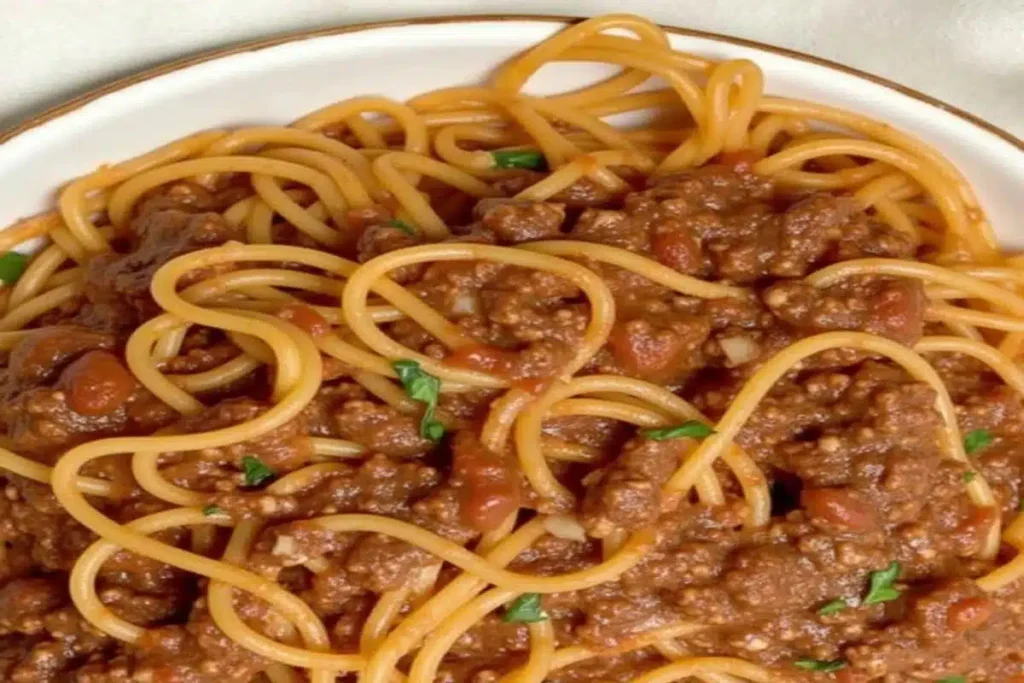
How to Store and Reheat Spaghetti Bolognese Recipe
Spaghetti Bolognese Recipe is a great dish to make in large batches because it stores well and can be easily reheated. Here are some tips for storing and reheating:
- Refrigerator: Store any leftovers in an airtight container in the refrigerator for up to 3-4 days. Make sure the sauce is completely cooled before transferring it to the container.
- Freezer: Bolognese sauce can be frozen for up to 3 months. Store it in a freezer-safe container or a zip-top bag. When ready to use, thaw it in the refrigerator overnight before reheating.
- Reheating: To reheat, place the sauce in a saucepan over medium heat, stirring occasionally until it is heated through. If the sauce is too thick, add a splash of water or broth to loosen it up. For reheating Spaghetti Bolognese Recipe that has already been combined, add a bit of water to a skillet and heat over medium-low, stirring until warmed.
Frequently Asked Questions
What exactly is spaghetti bolognese?
Spaghetti Bolognese Recipe is a popular Italian dish consisting of a hearty meat sauce served over spaghetti. The sauce is typically made from ground beef, tomatoes, carrots, celery, and onions, and is simmered slowly to build rich flavors.
What makes spaghetti bolognese taste better?
The secret to enhancing the flavor of spaghetti bolognese is slow simmering. Allowing the sauce to cook for a longer period helps the ingredients meld together, creating depth. Additionally, using wine and milk provides a balance of acidity and creaminess, making the sauce smoother and richer.
What is the difference between Bolognese sauce and spaghetti sauce?
Bolognese sauce is a meat-based sauce with a rich texture, originating from Bologna. It is distinct from general spaghetti sauce, which can include a variety of tomato-based sauces such as marinara. Bolognese emphasizes meat, whereas other spaghetti sauces may focus more on tomatoes.
What are the ingredients of Bolognese sauce?
The main ingredients for Bolognese sauce are ground beef, onions, carrots, celery, tomato paste, crushed tomatoes, wine, milk, olive oil, and a mix of herbs such as bay leaf, oregano, and basil.
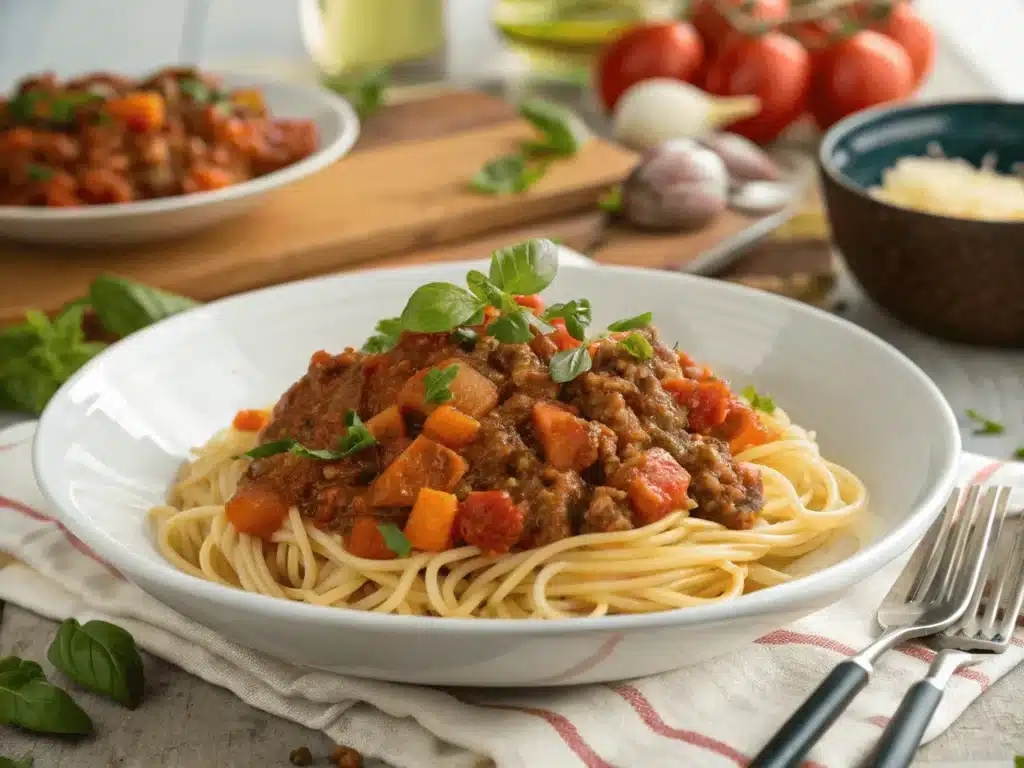
More Frequently Asked Questions
Can I make a Spaghetti Bolognese Recipe ahead of time?
Absolutely! In fact, Spaghetti Bolognese Recipe often tastes even better the next day as the flavors have had more time to meld. Make the sauce ahead of time and store it in the refrigerator for up to 3-4 days. Reheat it gently on the stovetop before serving.
What type of wine should I use in Bolognese sauce?
Both red and white wine work well in Bolognese sauce. Red wine adds a deeper, more robust flavor, while white wine adds a lighter, more delicate acidity. Choose a wine that you enjoy drinking, as the flavor will be concentrated in the sauce.
Can I substitute the ground beef in Bolognese sauce?
Yes, you can substitute ground beef with other meats such as ground turkey, chicken, pork, or even a mix of different meats. For a vegetarian option, try using lentils or mushrooms as a substitute.
Is Bolognese sauce keto-friendly?
Bolognese sauce can be made keto-friendly by serving it over zoodles (zucchini noodles) or spaghetti squash instead of traditional pasta. Make sure to use a low-carb tomato sauce and avoid any added sugars.
Conclusion
Spaghetti Bolognese Recipe is a timeless dish that has earned its place in kitchens around the world for good reason. With its rich, hearty flavors and comforting qualities, it’s the perfect choice for a family dinner, a gathering with friends, or even a special occasion. By using quality ingredients, taking your time to build flavors, and following the steps outlined in this guide, you can create a spaghetti bolognese that’s sure to impress.
Whether you stick with the classic recipe or experiment with one of the many variations, Spaghetti Bolognese Recipe is a dish that offers something for everyone. The joy of sharing a delicious meal, made with care, is truly what makes this recipe so special. So grab your apron, gather your ingredients, and enjoy the process of making (and eating!) this beloved Italian classic.
Don’t miss our Gluten Free Cheese Stick guide for verified safe options you can make or buy.

